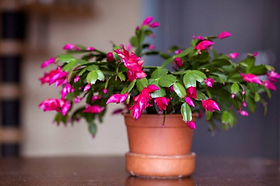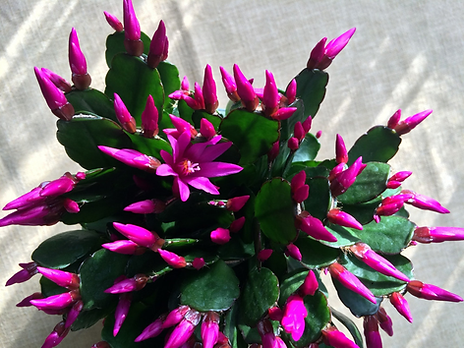A Christmas cactus, (Schlumbergera), is a small cactus that is native to Brazil. It is considered an epiphyte. An epiphyte is a plant that grows on the surface of another but is not a parasite. Unlike parasites, epiphytes get their nutrients from the rain, air, water and organic debris that surround them. Christmas cacti bloom around the holidays and are very easy to find now that they are cultivated in many parts of the world. This indoor plant adds beauty to the winter season.
This post contains information on soil, water and light requirements, when and which type of fertilize to use, how to promote blossoms, and how to propagate the plant. Read on to learn how to take care of a Christmas cactus.
(Some of the links within this post are affiliate links on which I receive a small compensation from the sale of certain items with no extra cost to you.)
(As an Amazon Associate I earn from qualifying purchases.)
Simple Requirements
A Christmas cactus is rather forgiving. If you forget to water it, it really won’t mind unless, of course, you forget for months on end!
Watering:
This cactus enjoys a slightly moist soil, but allow it to almost dry out between waterings in the fall and winter. Do not allow it to dry out completely and do not let it sit in water. Sitting in water will cause root and stem rot.
During active growth in the spring and summer, keep the soil slightly moist without allowing the soil to dry out. At this time it requires frequent and consistent waterings.
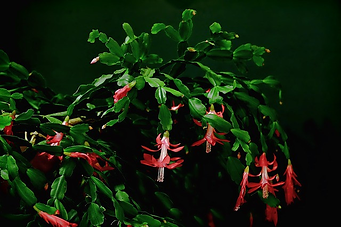
Lighting:
Christmas cacti thrive in medium light and will adapt to low light. Do not place the plant in direct sunlight. It will burn the leaves.
Temperature:
The Christmas cactus prefers temperatures between 60 and 70 degrees Fahrenheit (15-21C).
Humidity Levels:
Keep your plant in a room with average to high humidity levels. In order to increase humidity create a natural biome. Cluster the potted cactus with other indoor plants. Place a tray larger than the pot with pebbles (approximately 1 inch deep) under the pot and add water to the pebbles. This will create humidity for the plant.
Fertilizer:
Fertilize the cactus during its growing season, late winter through late summer. Feed it monthly with a houseplant fertilizer (Amazon Succulent Fertilizer) or a 20-20-20 (Amazon/Envy), or 20-10-20 water soluble formula. Stop fertilizing it in late summer to promote healthy leaf and bud growth.
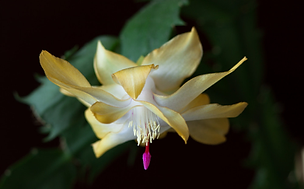
Soil and Repotting:
A Christmas cactus likes its roots somewhat crowded so there is no need to repot this plant yearly. Every 3 to 4 years is sufficient unless you see roots protruding from the pot. You can even wait until your plant looks a little unhealthy or droopy. A Christmas cactus will thrive in the same soil for many years.
DO NOT repot while the plant is in bloom! Wait until the blossoms have died off or wait until early spring. Then use a well drained, lightweight potting mixture (Amazon/All Natural Succulent Mix). Combine 2/3 of a good potting mix with 1/3 sand. Or you can purchase a commercial mix for bromeliads or succulents. Bromeliad is a family of plants that is usually epiphytic and clings to trees or other structures.
Purchase a pot slightly larger than the pot (Amazon/Succulent Pot) it is already in. Remove the plant and its root ball from the old pot and gently loosen its roots. If the soil has hardened around the roots, gently run water over it to loosen it.
Place the plant in a new pot that has a drainage hole and carefully refill the pot with fresh soil.
Pat down the soil and water the plant to remove any air pockets. Place it in a darker location for a couple of days and then resume its proper care.
Trimming And Other Basic Care:
Pinch off the dead blossoms in order to encourage new branching growth.
Keep an eye out for mealybugs or scale insects and control them with a good horticultural soap spray. (Amazon/Organic Neem Oil)
In the summer, you can place your cactus outside but do not put it in direct sunlight. Also, be aware of the amount of water it is naturally receiving. You may have to supplement by watering in a dry spell or bring the cactus inside during a wet season.
I like to keep mine inside. It adds beauty and oxygen to your home.
Rinse the plant with water to rid it of accumulated dust.
Forcing The Christmas Cactus To Bloom
I’m sure you either purchased it or received the cactus in full bloom. It’s easy to force the cactus to bloom again in time for the holiday season.
Simulate its natural dormancy cycle:
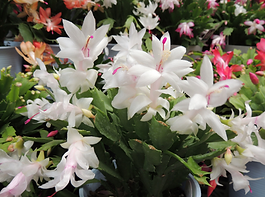
The Christmas cactus naturally forms buds when the daylight shortens and the days are cooler. You can simulate this dormancy period by following these directions.
In late September or early October, place your cactus in a north-facing window and/or an area which receives approximately 12 to 14 hours of darkness.
Place it in s room with a temperature range of between 50 and 60 degrees Fahrenheit (10-15 degrees C). Do not place the plant in a draft.
Do not fertilize during this dormancy cycle.
Allow the soil to thoroughly dry out, only watering once every few weeks. The plant will look a little stressed.
The periods of darkness, less water, cooler temperatures and lack of fertilizer will drive the plant to produce beautiful blossoms of pink, purple, red, orange, yellow or white. The color will depend on the variety of the plant.
Purchase Christmas Cacti Through Etsy
Propagating a Christmas Cactus
There are two ways to propagate a Christmas cactus, either by water or soil. In both processes, you need to remove some healthy stems from the plant.
A cactus leaf is called a pad. Carefully remove a healthy section of pads from the cactus (approximately 3 pads) by gently twisting it off. The pads are linked together so twist them at the link. Do not tear off the piece or it will damage the base of the pad where the root grows.
Water Technique:
After removing the section, allow the end of the pad where it was removed from the mother plant to dry out for 3 days to prevent it from soaking up too much water. The cutting should look thin but not wrinkly. Too much water will cause the section to rot.
Place the section in a glass of water, submerging half of a pad. Switch out the water every 3 to 4 days. Allow 3 weeks to see root growth. Let the root grow to approximately 2 inches, then plant the roots of the section in soil.
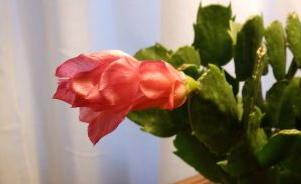
Potting:
Carefully place the cutting with roots into a fairly small pot with a drainage hole and good, well drained, succulent potting soil. Let the root extend down into the soil, gently pat the soil and water it until the soil is moist. Keep the pot in a warm location. It can tolerate early morning or late afternoon sun at this point. Water more frequently to keep it moist until you see significant growth.
After the cutting has formed into a small plant, slowly start reducing the water until the soil almost dries out between waterings.
You can add 2 to 3 sections into a pot at the same time.
Soil Technique:
Extract a section approximately 4 inches using the method above, and let it dry away from direct sunlight for 1 to 2 days. Place the bottom pad of the cutting into fresh potting soil. Moisten the soil, allowing it to get barely dry between waterings. It should grow roots within 2 to 3 weeks.
Either technique works, however, roots seem to develop quicker using water propagation.
The Many Colors of Christmas Cactus
Christmas cacti come in a variety of colors and shades. They include shades of fuchsia, pink, orange, yellow, white, red and sometimes a combination of colors. The colors can change or fade by being placed in too much light or in varying temperatures. However, the base color will not change.
White cacti can slightly change their hue due to environmental conditions. If the environment is a cool climate, the white cactus will take on a pink hue. Conversely, if it is placed in warmer conditions, it will remain pure white.
Also, if a cactus is watered too much or too little, it may change to a white color.
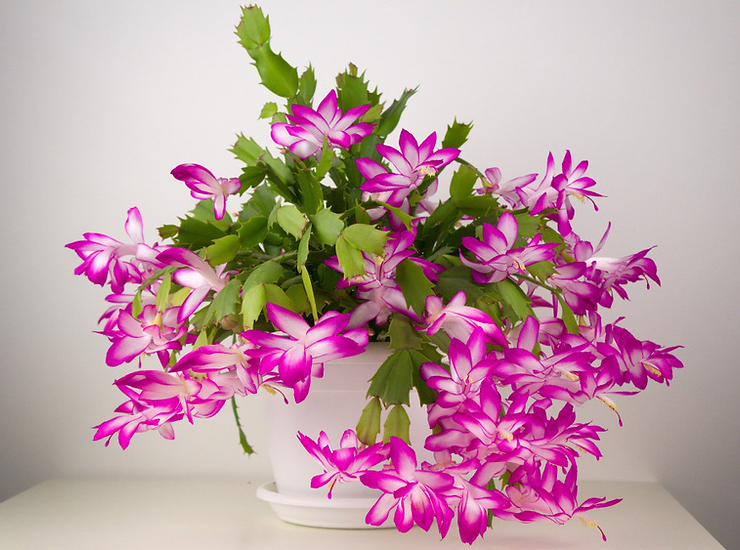
Conclusion – How To Take Care Of A Christmas Cactus
A Christmas cactus is one of the easiest and, I think, prettiest flowers you see during the holidays. If you monitor the watering, lighting, air temperature, and humidity, and fertilize once in awhile, you will not go wrong with this beautiful plant. To purchase a Christmas cactus and send it as a gift, click below.
I hope you have enjoyed this post. Please share it with others. Also, leave a comment below. I’d love to hear from you! If you enjoyed reading about Christmas cacti, click Indoor Plants for more tips.
Happy Gardening,
Nina

